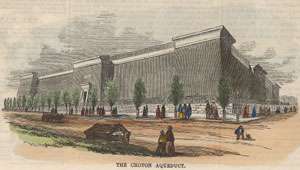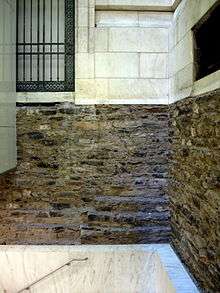Croton Distributing Reservoir

The Croton Distributing Reservoir, also known as the Murray Hill Reservoir, was an above-ground reservoir at 42nd Street and Fifth Avenue in the New York City borough of Manhattan. It supplied the city with drinking water during the 19th century. The reservoir was a man-made lake 4 acres (16,000 m2) in area, surrounded by massive, 50-foot (15 m) high, 25-foot (7.6 m) thick granite walls. Its facade was done in a vaguely Egyptian style.[1] Along the tops of the walls were public promenades, offering panoramic views. After construction was completed, it became a popular place to go strolling for residents of New York City; Edgar Allan Poe enjoyed his walks at this location.[2][3] The reservoir held a total capacity of 20 million US gallons (76,000 m3).[4]
When established, the Croton Aqueduct was NYC's foremost water source. Amidst great fanfare, water was introduced into the Croton Distributing Reservoir on July 4, 1842.[5] Prior to construction of the aqueduct, water was obtained from cisterns, wells and barrels from rain. The aqueduct and reservoir obtained their names from the water's source, a series of mostly underground conduits that would bring water from the Croton River in northern Westchester County to NYC's spigots.[6]
Demolition


The Croton Distributing Reservoir was torn down at the end of the century; in the 1890s. Today, the main branch of the New York Public Library and Bryant Park exist at that location. Some of the reservoir's original foundation can still be found in the South Court at the New York Public Library. Today water is primarily supplied to New York City via its three city water tunnels. The Central Park Reservoir still remains, but since 1993 has no longer been in use.[8]
Subway commuters can see a historical plaque showing the former reservoir. The plaque is located on the wall in the underground passageway that connects the Fifth Avenue station on the IRT Flushing Line and 42nd Street station on the IND Sixth Avenue Line.[9] A few years before the reservoir was torn down, there were two tablets affixed to the Reservoir.[10] The inscription was:
HISTORICAL AND DESCRIPTIVE ACCOUNT OF THE CROTON AQUEDUCT – The Law authorizing the construction of the work, passed May 2nd, 1834. Stephen Allen, William W. Fox, Saul Alley, Charles Dusenberry and Benjamin M. Brown were appointed Commissioners. During the year 1834, two surveys were made—one by DAVID B. DOUGLASS and the other by JOHN MARTINEAU. In April, 1835, a majority of the Electors of the City voted in favour of constructing the Aqueduct. On the 7th May following, the _Common Council_ "instructed the Commissioners to proceed with the work." David B. Douglass was employed as Chief Engineer until October, 1836; when he was succeeded by John B. Jervis. In March, 1837, Benjamin M. Brown resigned, and was succeeded by Thomas T. Woodruff. In March, 1840, the before mentioned Commissioners were succeeded by Samuel Stevens, John D. Ward, Zevedee Ring, Benjamin Birdsall and Samuel R. Childs. The work was commenced in May, 1837. On the 22nd June, 1842, the Aqueduct was so far completed that it received the Water from the Croton River Lake; on the 27th the Water entered the Receiving Reservoir and was admitted into this Reservoir on the succeeding 4th of July. The DAM at the Croton River is 40 feet high, and the overfall 251 feet in length. The CROTON RIVER LAKE is five miles long, and covers an area of 400 acres. The AQUEDUCT, from the DAM to this Reservoir, is 40½ miles long, and will deliver in twenty-four hours 60,000,000 imperial gallons. The capacity of the Receiving Reservoir is 150,000,000 gallons, and of this reservoir 20,000,000. The cost, to and including this Reservoir, nearly $9,000,000.
The second tablet stated:
CROTON AQUEDUCT – DISTRIBUTING RESERVOIR – COMMISSIONERS:
SAMUEL STEVENS
ZEBEDEE RING
JOHN D. WARD
BENJ^n BIRDSALL
SAMUEL R. CHILDS
ENGINEERS:JOHN B. JERVIS. CHIEF.
H^o ALLEN, PRIN^l ASSIST.
P. HASTIE, RESIDENT.BUILDERS:
THOMSON PRICE & SON.
COMMENCED A. D. MDCCCXXXVIII.
COMPLETED A. D. MDCCCXLII.
References
- ↑ "History: Reservoir Square". Bryant Park Corporation. Retrieved 2015-10-11.
- ↑ "New York Public Library at 42nd Street and Adjacent Bryant Park". Retrieved 2010-03-13.
- ↑ "New York Public Library". New York Architecture Images. Retrieved 2010-03-13.
- ↑ "Croton Water Supply System". ASCE Metropolitan Section. Retrieved 2016-11-12.
- ↑ "What a Day to Toast New York Drinking Water!". The New York Times. July 4, 1995. Retrieved 2010-03-13.
- ↑ Kadinsky, Sergey (2016) Hidden Waters of New York City Countryman Press. Pp. 22-26 ISBN 978-1-58157-355-8
- ↑ "Croton Aqueduct Remnants". Forgotten New York. Retrieved 10 June 2014.
- ↑ Fisher, Ian (October 28, 1993). "Central Park Reservoir to Stay as Is; New York Is to Leave It Undeveloped, Home to Waterfowl". The New York Times. Retrieved 2010-03-13.
- ↑ "There's No Stoppin' the Croton from Hoppin'". Forgotten NY. Retrieved 2010-03-13.
- ↑ Handbook of the New York Public Library. 1916. Retrieved 2010-03-13.
External links
| Wikimedia Commons has media related to Croton Distributing Reservoir. |
- Manhole Cover in the Water System
Coordinates: 40°45′12″N 73°58′57″W / 40.75333°N 73.98250°W